Corporate Finance Part II Budgetting, Financing Valuation
Bạn đang xem bản rút gọn của tài liệu. Xem và tải ngay bản đầy đủ của tài liệu tại đây (2.73 MB, 56 trang )
Kasper Meisner Nielsen
Corporate Finance: Part II
Budgetting, Financing & Valuation
Download free books at
Download free eBooks at bookboon.com
2
Corporate Finance: Part II
Budgetting, Financing & Valuation
Download free eBooks at bookboon.com
3
Corporate Finance: Part II – Budgetting, Financing & Valuation
1
st
edition
© 2010
bookboon.com
ISBN 978-87-7681-569-1
Download free eBooks at bookboon.com
Click on the ad to read more
Corporate Finance: Part II
4
Contents
Contents
1 Capital Budgeting 6
1.1 Cost of capital with preferred stocks 7
1.2 Cost of capital for new projects 7
1.3 Alternative methods to adjust for risk 7
1.4 Capital budgeting in practise 8
1.5 Why projects have positive NPV 10
2 Market Eciency 12
2.1 Tests of the ecient market hypothesis 13
2.2 Behavioural nance 16
3 Corporate Financing and Valuation 17
3.1 Debt characteristics 17
3.2 Equity characteristics 18
3.3 Debt policy 18
3.4 How capital structure aects the beta measure of risk 22
3.5 How capital structure aects company cost of capital 23
www.sylvania.com
We do not reinvent
the wheel we reinvent
light.
Fascinating lighting offers an infinite spectrum of
possibilities: Innovative technologies and new
markets provide both opportunities and challenges.
An environment in which your expertise is in high
demand. Enjoy the supportive working atmosphere
within our global group and benefit from international
career paths. Implement sustainable ideas in close
cooperation with other specialists and contribute to
influencing our future. Come and join us in reinventing
light every day.
Light is OSRAM
Download free eBooks at bookboon.com
Corporate Finance: Part II
5
Contents
3.6 Capital structure theory when markets are imperfect 23
3.7 Introducing corporate taxes and cost of nancial distress 24
3.8 e Trade-o theory of capital structure 26
3.9 e pecking order theory of capital structure 27
3.10 A nal word on Weighted Average Cost of Capital 28
3.11 Dividend policy 30
4 Options 36
4.1 Option value 37
4.2 What determines option value? 39
4.3 Option pricing 41
5 Real Options 47
5.1 Expansion option 47
5.2 Timing option 47
5.3 Abandonment option 48
5.4 Flexible production option 48
5.5 Practical problems in valuing real options 49
6 Appendix: Overview of Formulas 50
Index 56
Download free eBooks at bookboon.com
Corporate Finance: Part II
6
Capital Budgeting
1 Capital Budgeting
e rms cost of capital is equal to the expected return on a portfolio of all the company’s existing
securities. In absence of corporate taxation the company cost of capital is a weighted average of the
expected return on debt and equity:
1)
equitydebt
r
equitydebt
equity
r
equitydebt
debt
assets
r capital ofcost Company
e rm’s cost of capital can be used as the discount rate for the average-risk of the rm’s projects.
Cost of capital in practice
Cost of capital is dened as the weighted average of the expected return on debt and equity
equitydebt
r
equitydebt
equity
r
equitydebt
debt
assets
r capital ofcost Company
To estimate company cost of capital involves four steps:
1. Determine cost of debt
- Interest rate for bank loans
- Yield to maturity for bonds
2. Determine cost of equity
- Find beta on the stock and determine the expected return using CAPM:
r
equity
= r
risk free
+ β
equity
( r
market
– r
risk free
)
- Beta can be estimated by plotting the return on the stock against the return on the market, and, t a
regression line to through the points. The slope on this line is the estimate of beta.
3. Find the debt and equity ratios
- Debt and equity ratios should be calculated by using market value (rather than book value) of debt and
equity.
4. Insert into the weighted average cost of capital formula
Download free eBooks at bookboon.com
Corporate Finance: Part II
7
Capital Budgeting
1.1 Cost of capital with preferred stocks
Some rm has issued preferred stocks. In this case the required return on the preferred stocks should
be included in the company’s cost of capital.
2)
preferredcommondebt
r
valuefirm
equitypreferred
r
valuefirm
equitycommon
r
valuefirm
debt
capital ofcost Company
Where rm value equals the sum of the market value of debt, common, and preferred stocks.
e cost of preferred stocks can be calculated by realising that a preferred stock promises to pay a xed
dividend forever. Hence, the market value of a preferred share is equal to the present value of a perpetuity
paying the constant dividend:
r
DIV
stocks preferred of Price
Solving for r yields the cost of preferred stocks:
3)
P
DIV
r
preferred
stocks preferred ofCost
us, the cost of a preferred stock is equal to the dividend yield.
1.2 Cost of capital for new projects
A new investment project should be evaluated based on its risk, not on company cost of capital. e
company cost of capital is the average discount rate across projects. us, if we use company cost of
capital to evaluate a new project we might:
- Reject good low-risk projects
- Accept poor high-risk projects
True cost of capital depends on project risk. However, many projects can be treated as average risk.
Moreover, the company cost of capital provide a good starting reference to evaluate project risk
1.3 Alternative methods to adjust for risk
An alternative way to eliminate risk is to convert expected cash ows to certainty equivalents. A certainty
equivalent is the (certain) cash ow which you are willing to swap an expected but uncertain cash ow
for. e certain cash ow has exactly the same present value as an expected but uncertain cash ow.
e certain cash ow is equal to
4)
)1( rPVflowcashCertain
Where PV is the present value of the uncertain cash ow and r is the interest rate.
Download free eBooks at bookboon.com
Corporate Finance: Part II
8
Capital Budgeting
1.4 Capital budgeting in practise
Capital budgeting consists of two parts; 1) Estimate the cash ows, and 2) Estimate opportunity cost
of capital. us, knowing which cash ows to include in the capital budgeting decision is as crucial as
nding the right discount factor.
1.4.1 What to discount?
1. Only cash ows are relevant
- Cash ows are not accounting prots
2. Relevant cash ows are incremental
- Include all incidental eects
- Include the eect of imputation
- Include working capital requirements
- Forget sunk costs
- Include opportunity costs
- Beware of allocated overhead costs
1.4.2 Calculating free cash ows
Investors care about free cash ows as these measures the amount of cash that the rm can return
to investors aer making all investments necessary for future growth. Free cash ows dier from net
income, as free cash ows are
- Calculated before interest
- Excluding depreciation
- Including capital expenditures and investments in working capital
Free cash ows can be calculated using information available in the income statement and balance sheet:
5)
capitalworkingininvestment
assetsfixedininvestmentondepreciatitaxafterprofitflowcashFree
1.4.3 Valuing businesses
e value of a business is equal to the present value of all future (free) cash ows using the aer-tax
WACC as the discount rate.
A project’s free cash ows generally fall into three categories
1. Initial investment
- Initial outlay including installation and training costs
- Aer-tax gain if replacing old machine
Download free eBooks at bookboon.com
Corporate Finance: Part II
9
Capital Budgeting
2. Annual free cash ow
- Prots, interest, and taxes
- Working capital
3. Terminal cash ow
- Salvage value
- Taxable gains or losses associated with the sale
For long-term projects or stocks (which last forever) a common method to estimate the present value
is to forecast the free cash ows until a valuation horizon and predict the value of the project at the
horizon. Both cash ows and the horizon values are discounted back to the present using the aer-tax
WACC as the discount rate:
6)
t
t
t
t
WACC
PV
WACC
FCF
WACC
FCF
WACC
FCF
PV
)1()1()1(
)1(
2
21
Where FCF
i
denotes free cash ows in year i, WACC the aer-tax weighted average cost of capital and
PV
t
the horizon value at time t.
ere exist two common methods of how to estimate the horizon value
1. Apply the constant growth discounted cash ow model, which requires a forecast of the free
cash ow in year t+1 as well as a long-run growth rate (g):
gWACC
FCF
PV
t
t
1
2. Apply multiples of earnings, which assumes that the value of the rm can be estimated
as a multiple on earnings before interest, taxes (EBIT) or earnings before interest, taxes,
depreciation, and amortization (EBITDA):
EBITDAMultipleEBITDAPV
EBITMultipleEBITPV
t
t
Example:
- If other rms within the industry trade at 6 times EBIT and the rm’s EBIT is forecasted to be €10 million,
the terminal value at time t is equal to 6·10 = €60 million.
Download free eBooks at bookboon.com
Corporate Finance: Part II
10
Capital Budgeting
Capital budgeting in practice
Firms should invest in projects that are worth more than they costs. Investment projects are only worth more than
they cost when the net present value is positive. The net present value of a project is calculated by discounting future
cash ows, which are forecasted. Thus, projects may appear to have positive NPV because of errors in the forecasting.
To evaluate the inuence of forecasting errors on the estimated net present value of the projects several tools exists:
- Sensitivity analysis
- Analysis of the eect on estimated NPV when a underlying assumption changes, e.g. market size, market
share or opportunity cost of capital.
- Sensitivity analysis uncovers how sensitive NPV is to changes in key variables.
- Scenario analysis
- Analyses the impact on NPV under a particular combination of assumptions. Scenario analysis is particular
helpful if variables are interrelated, e.g. if the economy enters a recession due to high oil prices, both the
rms cost structure, the demand for the product and the ination might change. Thus, rather than analysing
the eect on NPV of a single variable (as sensitivity analysis) scenario analysis considers the eect on NPV of a
consistent combination of variables.
- Scenario analysis calculates NPV in dierent states, e.g. pessimistic, normal, and optimistic.
- Break even analysis
- Analysis of the level at which the company breaks even, i.e. at which point the present value of revenues
are exactly equal to the present value of total costs. Thus, break-even analysis asks the question how much
should be sold before the production turns protable.
- Simulation analysis
- Monte Carlo simulation considers all possible combinations of outcomes by modelling the project. Monte
Carlo simulation involves four steps:
1. Modelling the project by specifying the project’s cash ows as a function of revenues, costs, depreciation
and revenues and costs as a function of market size, market shares, unit prices and costs.
2. Specifying probabilities for each of the underlying variables, i.e. specifying a range for e.g. the expected
market share as well as all other variables in the model
3. Simulate cash ows using the model and probabilities assumed above and calculate the net present value
1.5 Why projects have positive NPV
In addition to performing a careful analysis of the investment project’s sensitivity to the underlying
assumptions, one should always strive to understand why the project earns economic rent and whether
the rents can be sustained.
Economic rents are prots than more than cover the cost of capital. Economic rents only occur if one has
• Better product
• Lower costs
• Another competitive edge
Download free eBooks at bookboon.com
Click on the ad to read more
Corporate Finance: Part II
11
Capital Budgeting
Even with a competitive edge one should not assume that other rms will watch passively. Rather one
should try to identify:
- How long can the competitive edge be sustained?
- What will happen to prots when the edge disappears?
- How will rivals react to my move in the meantime?
- Will they cut prices?
- Imitate the product?
Sooner or later competition is likely to eliminate economic rents.
360°
thinking
.
© Deloitte & Touche LLP and affiliated entities.
Discover the truth at www.deloitte.ca/careers
Download free eBooks at bookboon.com
Corporate Finance: Part II
12
Market Eciency
2 Market Eciency
In an ecient market the return on a security is compensating the investor for time value of money and
risk. e ecient market theory relies on the fact that stock prices follow a random walk, which means
that price changes are independent of one another. us, stock prices follow a random walk if
- e movement of stock prices from day to day do not reect any pattern
- Statistically speaking
- e movement of stock prices is random
- Time series of stock returns has low autocorrelation
In an ecient market competition ensures that
- New information is quickly and fully assimilated into prices
- All available information is reected in the stock price
- Prices reect the known and expected, and respond only to new information
- Price changes occur in an unpredictable way
e ecient market hypothesis comes in three forms: weak, semi-strong and strong eciency
Weak form eciency
- Market prices reect all historical price information
Semi-strong form eciency
- Market prices reect all publicly available information
Strong form eciency
- Market prices reect all information, both public and private
Ecient market theory has been subject to close scrutiny in the academic nance literature, which has
attempted to test and validate the theory.
Download free eBooks at bookboon.com
Corporate Finance: Part II
13
Market Eciency
2.1 Tests of the ecient market hypothesis
2.1.1 Weak form
e weak form of market eciency has been tested by constructing trading rules based on patterns
in stock prices. A very direct test of the weak form of market ecient is to test whether a time series
of stock returns has zero autocorrelation. A simple way to detect autocorrelation is to plot the return on a
stock on day t against the return on day t+1 over a suciently long time period. e time series of returns
will have zero autocorrelation if the scatter diagram shows no signicant relationship between returns on
two successive days.
Example:
- Consider the following scatter diagram of the return on the FTSE 100 index on London Stock Exchange for two
successive days in the period from 2005-6.
-2
-1
0
1
2
-2 -1 0 1 2
Return on day t
Return on day t+1
- As there is no signicant relationship between the return on successive days, the evidence is supportive of the
weak form of market eciency.
2.1.2 Semi-strong form
e semi-strong form of market eciency states that all publicly available information should be reected
in the current stock price. A common way to test the semi-strong form is to look at how rapid security
prices respond to news such as earnings announcements, takeover bids, etc. is is done by examining
how releases of news aect abnormal returns where
- Abnormal stock return = actual stock return – expected stock return



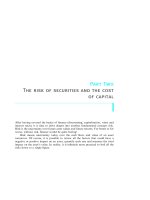
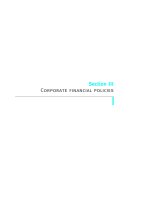
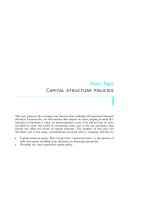
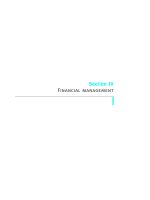
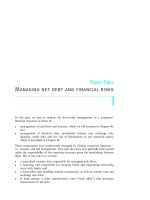
![[TO BE PUBLISHED IN THE GAZETTE OF INDIA, EXTRAORDINARY PART-II, SECTION-3, SUB-SECTION (i)] - MINISTRY OF CORPORATE AFFAIRS potx](https://media.store123doc.com/images/document/14/rc/th/medium_X6qKb5VYeN.jpg)
